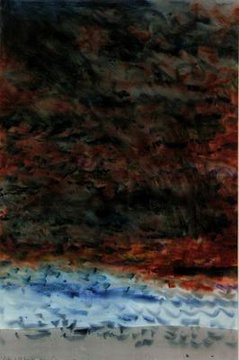Colin McCahon

Bio.
‘Colin McCahon is the outstanding figure in New Zealand visual art of the twentieth century. He was a great painter and a profound thinker. He was also a teacher, curator, and critic whose contribution to art in New Zealand is immense.’ – Preface to "Gates and Journeys" information brochure, Auckland City Art Gallery centenary exhibition.
Colin McCahon was born in 1919 in Timaru, though he spent most of his early years in Dunedin. He loved attending local exhibitions at the Dunedin Art Gallery with his family. In 1933, convinced he wanted to be an artist, McCahon attended Saturday morning art classes taken by Russell Clark.
After leaving Otago Boys High, which he hated, McCahon attended King Edward Technical College Art School as a part-time student. Around this time McCahon would spend his summers in the Nelson area, cycling there from Dunedin to work in the orchards or tobacco fields. The experience of these long journeys through the landscape provided a continuous source of inspiration was to echo throughout his career
When the Otago Art Society refused to hang one of McCahon’s works in 1940, other young artists protested at the decision. The Society subsequently relented, and the painting was included in the exhibition.
In 1945 McCahon married Anne Hamblett in Dunedin. As a wedding present they received a copy of G.A. Cotton’s The Geomorphology of New Zealand, a book that had a great influence on McCahon’s art. His landscapes are often stark and empty (rather than picturesque), raising questions about the human histories of these seemingly unpopulated landscapes.
Though never a member of any church, McCahon acknowledged that religious questions were central to his work. From 1946 his paintings began to reflect this increasing fascination, as he ‘peopled’ empty New Zealand landscapes with the characters and events of Biblical stories. By doing so he was referring to a long established tradition within religious art.
In the 1940s words began to appear in McCahon’s work. While the resulting paintings were often criticised by the public, it was important to McCahon that his messages were properly understood. He believed the directness of words could help, provide a ‘way in’ to his images. He was aware also of the long tradition of using words within painted images, especially in religious art.
In 1947 McCahon became a member of ‘The Group’, a collection of progressive Christchurch artists to which Rita Angus also belonged. He exhibited regularly with The Group until it disbanded in 1977.
McCahon moved to Auckland in 1953. He lived in Titirangi, and around this time his landscapes featured beach, sea, sky, land, boats and kauri trees, all aspects of his immediate environment. McCahon worked at the Auckland City Art Gallery, starting as a cleaner, then later becoming Keeper (custodian of the paintings) and ultimately Deputy Director.
In 1958 McCahon’s Gallery job enabled him to travel to the United States to view the major art galleries. This overseas trip, during which he viewed much European and American art, including contemporary works, was extremely influential.
On his return from the United States McCahon painted the Northland Panels. This large work demonstrates both the influence of his American trip and his recurring interest in journeys – not only the ‘journey’ McCahon made (in memory) to Northland to paint the work, but also the ‘journey’ the viewer makes when walking past a sequence of panels.
In 1961 McCahon started work on his Gate series of paintings. These abstract paintings reflect McCahon’s concern at nuclear war and the atomic bomb, and demonstrate his hope for a solution or ‘way through’.
McCahon was appointed lecturer at Elam School of Art at the University of Auckland in 1964. From 1965, McCahon worked almost exclusively in black and white, and during the sixties produced a number of works combining numbers and texts, such as Io and Lark’s Song. Lark’s Song was based on a poem by Matire Kereama, an eighty year old elder of the Aupouri tribe, whose book The Tail of the Fish deepened McCahon’s interest in Māoritanga and Māori imagery.
McCahon left teaching in 1970 to paint full-time. During this period he produced both word and landscape paintings, though words increasingly began to dominate. Works from this period include Victory Over Death 2, Gate III and the Necessary Protection series, as well as numerous landscapes of the Kaipara area.
In 1972 the Auckland City Art Gallery mounted a survey exhibition of McCahon’s work that later toured the country. Six years later the New Zealand Government presented Victory Over Death 2 to the Government of Australia. Although this reflected the high esteem in which his name was now held, criticism earlier in his career made him suspicious of acceptance of his work.
McCahon commenced no new paintings after 1980, and died in 1987 after a long illness.
Text originally published in Tai Awatea, Te Papa's onfloor multimedia database.
